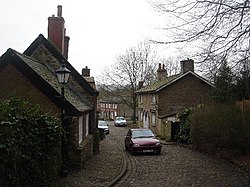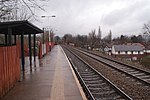South Turton
Areas of Greater ManchesterGeography of the Metropolitan Borough of BoltonGreater Manchester geography stubsUnparished areas in Greater ManchesterWest Pennine Moors
South Turton is an unparished area of the Metropolitan Borough of Bolton, in Greater Manchester, England. Historically the southern part of Turton, and within the Historic County of Lancashire, it lies on the southern slopes of the West Pennine Moors, and has a population of 25,067.South Turton was created in 1974 from the smaller urban area of the former Turton Urban District. This unparished area includes Bradshaw, Bromley Cross, Harwood, Dunscar, Eagley, and Egerton.
Excerpt from the Wikipedia article South Turton (License: CC BY-SA 3.0, Authors).South Turton
Lea Gate,
Geographical coordinates (GPS) Address Nearby Places Show on map
Geographical coordinates (GPS)
| Latitude | Longitude |
|---|---|
| N 53.606 ° | E -2.4 ° |
Address
Lea Gate
Lea Gate
BL2 3HP
England, United Kingdom
Open on Google Maps





